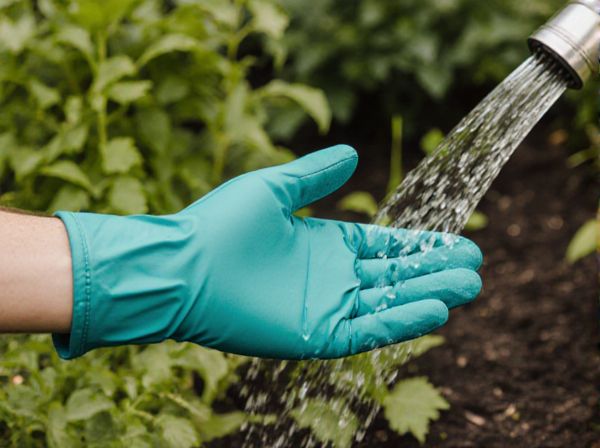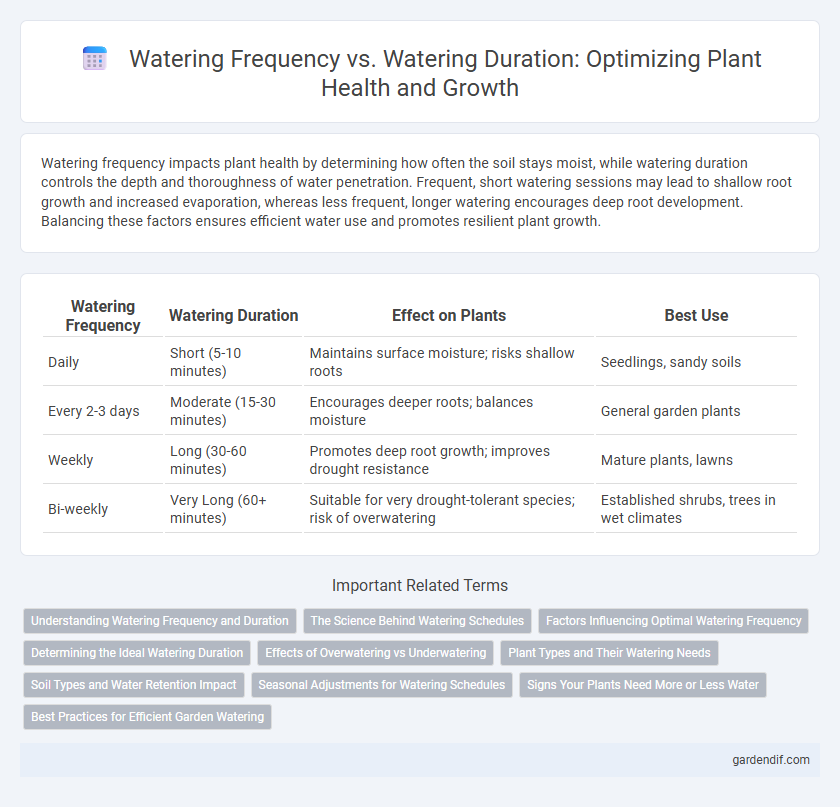
Watering frequency vs Watering duration Illustration
Watering frequency impacts plant health by determining how often the soil stays moist, while watering duration controls the depth and thoroughness of water penetration. Frequent, short watering sessions may lead to shallow root growth and increased evaporation, whereas less frequent, longer watering encourages deep root development. Balancing these factors ensures efficient water use and promotes resilient plant growth.
Table of Comparison
| Watering Frequency | Watering Duration | Effect on Plants | Best Use |
|---|---|---|---|
| Daily | Short (5-10 minutes) | Maintains surface moisture; risks shallow roots | Seedlings, sandy soils |
| Every 2-3 days | Moderate (15-30 minutes) | Encourages deeper roots; balances moisture | General garden plants |
| Weekly | Long (30-60 minutes) | Promotes deep root growth; improves drought resistance | Mature plants, lawns |
| Bi-weekly | Very Long (60+ minutes) | Suitable for very drought-tolerant species; risk of overwatering | Established shrubs, trees in wet climates |
Understanding Watering Frequency and Duration
Watering frequency refers to how often plants receive water, while watering duration is the length of time water is applied during each session. Both factors influence soil moisture levels, with frequent, short watering promoting surface moisture and longer, less frequent watering encouraging deeper root growth. Optimal watering schedules depend on plant species, soil type, and environmental conditions to ensure efficient water use and healthy plant development.
The Science Behind Watering Schedules
Watering frequency and watering duration directly influence soil moisture levels and plant health by determining how deeply water penetrates the root zone and how often plants receive hydration. Scientific studies show that infrequent, deep watering encourages roots to grow deeper, enhancing drought resistance, while frequent shallow watering often leads to surface root development and increased susceptibility to stress. Optimizing watering schedules based on soil type, plant species, and environmental conditions maximizes water efficiency and promotes sustainable plant growth.
Factors Influencing Optimal Watering Frequency
Optimal watering frequency depends on variables such as soil type, plant species, climate, and seasonal changes, which affect moisture retention and evaporation rates. Sandy soils require more frequent watering with shorter durations, while clay soils benefit from less frequent, deeper watering to promote root growth. Plant water needs fluctuate with temperature, humidity, and growth stages, making it crucial to adjust frequency rather than just watering duration for efficient hydration.
Determining the Ideal Watering Duration
Determining the ideal watering duration requires balancing soil moisture retention with plant water needs to prevent overwatering or underwatering. Monitoring soil texture, plant species, and climate conditions ensures watering duration matches how long roots need to absorb water effectively. Precise timing based on evapotranspiration rates optimizes root hydration while conserving water resources.
Effects of Overwatering vs Underwatering
Watering frequency and watering duration critically influence plant health, with overwatering causing root rot and nutrient leaching, while underwatering leads to dehydration and stunted growth. Excessive watering suffocates roots by reducing oxygen availability, promoting fungal diseases, whereas insufficient watering triggers wilting and leaf drop due to water stress. Optimizing both frequency and duration ensures balanced soil moisture, supporting nutrient uptake and robust plant development.
Plant Types and Their Watering Needs
Succulent plants require infrequent watering with longer intervals to prevent root rot, while tropical plants benefit from moderate watering frequency combined with brief watering durations to maintain consistent soil moisture. Deep-rooted plants need less frequent but longer watering sessions to ensure water penetrates to the root zone, whereas shallow-rooted plants thrive with more frequent, shorter watering to avoid drying out. Understanding the specific water absorption and retention capabilities of different plant types helps optimize watering schedules, promoting healthier growth and preventing overwatering or underwatering.
Soil Types and Water Retention Impact
Watering frequency and watering duration must be adjusted according to soil types and their water retention capacity to optimize plant health. Sandy soils with low water retention require more frequent, shorter watering sessions to prevent dehydration, whereas clay soils retain moisture longer, benefiting from less frequent but deeper watering to ensure thorough saturation. Understanding the interaction between soil texture and water retention improves irrigation efficiency and supports sustainable water use.
Seasonal Adjustments for Watering Schedules
Watering frequency and duration must be adjusted seasonally to match plant needs and environmental conditions. During hot summer months, increasing the frequency with shorter watering durations prevents soil drying and promotes deep root growth, while in cooler seasons, less frequent but longer watering sessions help maintain adequate moisture without waterlogging. Monitoring soil moisture and local weather patterns ensures optimal watering schedules that conserve water and support plant health year-round.
Signs Your Plants Need More or Less Water
Overwatering symptoms include yellowing leaves, wilting despite moist soil, and root rot, indicating you should reduce watering duration while maintaining frequency. Underwatering signs such as dry, brittle leaves and soil pulling away from the pot suggest increasing watering duration or frequency is necessary. Monitoring soil moisture levels and plant health helps optimize both watering frequency and duration for balanced hydration.
Best Practices for Efficient Garden Watering
Watering frequency and watering duration significantly impact garden health and water efficiency, with best practices recommending deep, infrequent watering over shallow, frequent sessions to promote strong root growth. Adjusting watering schedules according to soil type, plant species, and climate conditions ensures optimal moisture retention and reduces water waste. Employing drip irrigation systems and mulching further enhances water absorption and minimizes evaporation, supporting sustainable garden maintenance.
Watering frequency vs Watering duration Infographic

 gardendif.com
gardendif.com